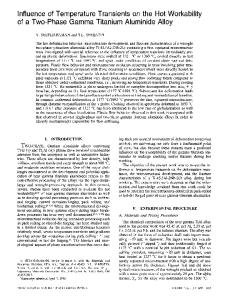Workability of A Dual Phase Titanium Aluminide-TiB 2 Xd TM Composite
- PDF / 3,087,061 Bytes
- 6 Pages / 420.48 x 639 pts Page_size
- 46 Downloads / 271 Views
WORKABILITY OF A DUAL PHASE TITANIUM ALUMINIDE-TiB 2 XDTM COMPOSITE
D. ZHAO, K.G. ANAND, J.J. VALENCIA, AND S.J. WOLFF Metalworking Technology, Inc., 1450 Scalp Avenue, Johnstown, PA 15904, U.S.A. ABSTRACT High temperature compression tests have been performed on a Ti-44a/o Al-3a/o V-7.5v/o 0 TiB2 XD composite over the temperature range 1000 to 1300 C and the strain rate range 10-3 to 10s-0. The workability of this material for metalforming processes was determined using both dynamic material modeling and workability testing approaches to cover both internal and surface cracking. At higher temperatures and strain rates internal fracture occurred in the material, while at lower temperatures and higher strain rates surface cracks occurred. Use of lower temperatures and strain rates inhibited internal instabilities and surface cracking in the composite. A finite element model (FEM) was developed to describe the stress and strain states during the deformation process. Mechanical flow behavior obtained from the compression tests was used as input to the model. A fracture criterion developed from Kuhn's surface crack equation was coupled with the FEM model to predict bulk formability in a forging process. INTRODUCTION Titanium aluminide matrix composites have attracted much attention recently for their potential use as structural materials in the aerospace industry [1,2]. While the materials are known for their high specific strength and modulus at elevated temperatures [3], their low ductility and fracture toughness may limit their workability. The workability of the composites must be determined before any successful metal forming process is designed. Prior work has indicated that the grain refining effect of the TiB2 reinforcement increases the hot workability of the as-cast XD composite 141. Other work studied the workability of a XD composite as a function of flow localization 151. The objective of the present work is to determine the workability limits of a dual phase ((X2+y) Ti-44AI-3V-7.5 V/o TiB 2 XD composite using both the dynamic material modeling (DMM) [6-8] and the workability testing approaches [9]. Processing and workability maps were developed to evaluate the most favorable conditions for processing in terms of temperature and strain rate. The workability data were combined with a fracture criterion [10] to predict crack formation in bulk forming processes. In this paper, a forging process is simulated for defect prediction. EXPERIMENTAL PROCEDURE The material used in this work was a Ti-44AI-3V-7.5 V/bTiB 2 XD composite. The ascast material was HIP'ed to close porosity and to homogenize the ingot microstructure. Figure I shows the optical microstructure of the as-HIP'ed composite. This consists of an (ac2+y) lamellar matrix with a uniform distribution of the TiB 2 reinforcement. The grain size of the matrix was found to be approximately 30 i.tm and the size of irregular shaped TiB 2 particulates varied from I to 15 gtm. Compression tests were conducted on cylindrical specimens with a diameter of 12.7 mm
Data Loading...











